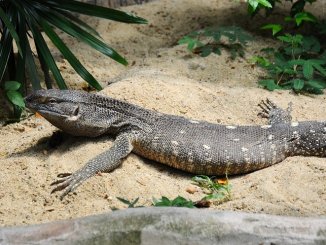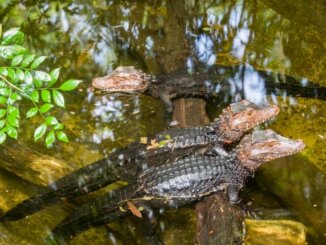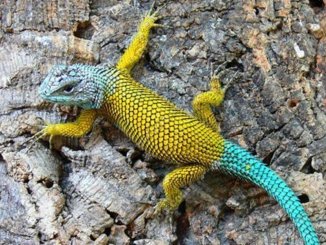The toad-headed agama is a small, arboreal beginner-friendly lizard. It’s famous for unfolding the colorful skin flaps at the corners of its mouth.
This unfurling creates a vibrant, easy-recognizable display that gives it the ”toad-headed” nomenclature.
Toad-headed agamas are easy lizards to keep. Their easy behavior, distinctive display, and small size make them popular among reptile collectors and pet owners.
Toad-Headed Agama Overview
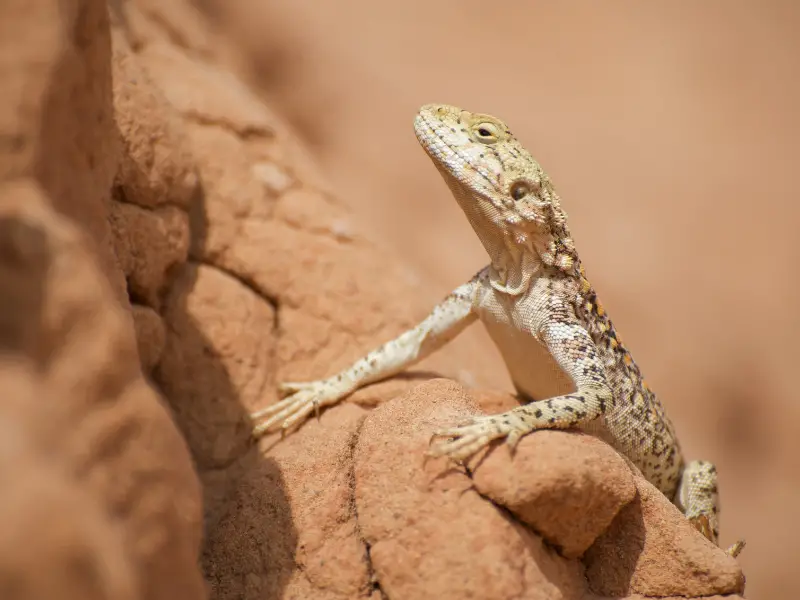
| Common name | Toad-headed agama, secret toadhead agama |
| Scientific name | Phrynocephalus mystaceus |
| Natural habitat | Sand dunes that are high and unvegetated |
| Adult size | 9 to 10 inches |
| Average lifespan | 2.5 to 3 years |
| Diet | Insects including crickets, worms, cockroaches, and beetles |
| Housing | A 20 gallon terrarium |
| Experience | Beginner |
Origin
The toad-headed agama (Phrynocephalus mystaceus) originates in southern Russia all the way to the north-west of China and down to the north of Iran, Afghanistan, Turkmenistan, Tajikistan, Kyrgyzstan, and Uzbekistan.
This small lizard primarily lives in desert and semi-arid areas. Since they spend much time above ground, they require rocks or branches in their enclosure.
Appearance And Behavior
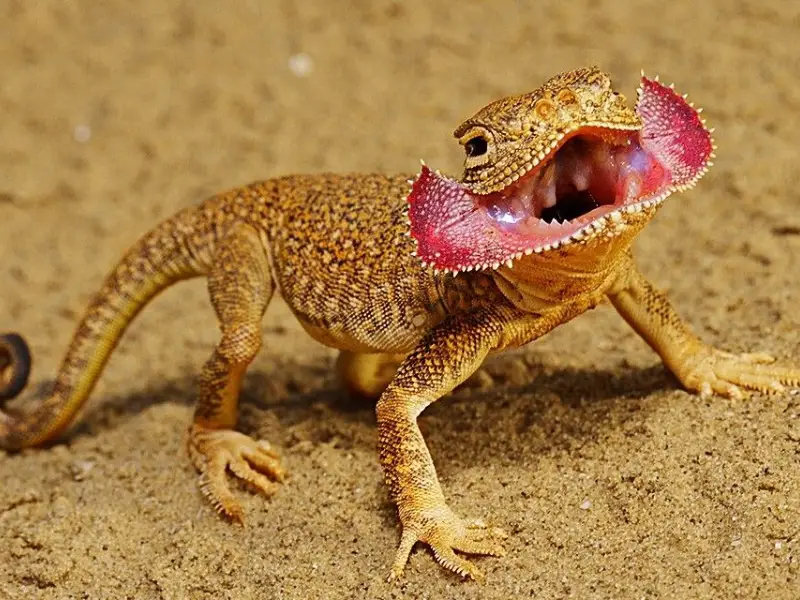
The toad-headed agama sports a large triangular-shaped head with a long tail. This arboreal lizard typically has dark-brown scales on the back of its body and features a black-tipped tail.
Its color may vary depending on the location where it originates from.
Males are more colorful than females. However, you can only really see this difference when compared side-by-side.
Like most agamas, the toad-headed agama adopts a “sit-and-wait” hunting strategy.
Their curious eyes will dart around the environment, giving them an inquisitive and intelligent attitude. As social animals, they can quickly feel stressed when left alone.
So, it’s best to keep them in groups.
Size And Lifespan
A healthy toad-headed agama can grow up to an average of 9 to 10 inches as an adult.
In the wild, these lizards can live between 2.5 to 3 years. If well taken care of, pet owners and collectors can expect them to live much longer though.
Diseases and human error are often the leading cause of premature death.
As they grow older, these lizards tend to slow down and become less active.
Temperament
The toad-headed agama is a steady, calm lizard. Their peaceful attitude makes them ideal pets for first-time owners.
Remember, temperament can differ between animals. So, even though these agamas are generally docile, some may hiss or bite if provoked.
Careless handling can teach them to respond aggressively when inexperienced owners handle them.
Housing The Toad Headed Agama
The toad-headed agama requires a large, warm terrarium with plants and branches. It also needs several hiding places to keep them comfortable.
A happy agama will enjoy staying on the warm ground or roaming around the foreground of the terrarium.
Enclosure Size
Toad-headed agamas are desert-dwelling lizards. As such, they love large, open spaces. Generally, the larger the enclosure, the better they will do.
The terrarium should be no smaller than 20 gallons though. This is the minimum enclosure size for one of these lizards.
A plastic or glass enclosure covered with gauze is perfect for your pet agama. When keeping several agamas in an enclosure, never put 2 males in the same space.
The males will fight, which will stress out the females. A ratio of one male for every seven females is typically best.
Lighting
Since these agamas originate from semi-arid desert areas, they love basking in the light. So, a full-spectrum lamp is a must. Keep the full-spectrum light on for at least 10 hours daily.
They also require UV lighting. The UV lamp helps the lizard synthesize vitamin D3. This vitamin is essential as it prevents metabolic bone disease (MBD).
Temperature And Humidity
The toad-headed agama requires a terrarium that’s a constant 93°F during the day. At night the temperature within the enclosure can drop to 78°F.
Spray the enclosure several times weekly to ensure the humidity doesn’t drop too low. Humidity levels should be between 40 and 50% for these lizards.
If owners are concerned about moisture, they should add a shallow water bowl in the enclosure. This bowl should be big enough for the agama to fit into.
Substrate And Decoration
A spacious and dry enclosure is ideal for a toad-headed agama. The terrarium should have a deep sand layer.
The sand shouldn’t be the type that retains water as you don’t want to create an environment that is too moist.
One side of the sand substrate can be slightly damp though as this is ideal for burrowing – an activity that agamas love.
Add some decorations like rocky slabs, branches, and bark that the agama can use as a cover or perch.
As an arboreal desert-dweller, the agama needs an enclosure with plenty of climbing spaces and variety.
Cleaning
Regular cleaning of the enclosure is essential to the health of any reptile.
Change the water in the bowl and spot-clean the enclosure daily.
Replace the substrate after four months. At the same time, you should deep clean the enclosure.
Avoid cleaning the enclosure with harsh chemicals or cleaning products. Water with a tiny drop of soap is usually enough.
You don’t need to remove the agama while spot-cleaning the enclosure. However, if you’re deep cleaning, it’s best to put your pet in a temporary enclosure that is deep and spacious.
Add a water bowl, and ensure it’s warm enough.
Toad-Headed Agama Care
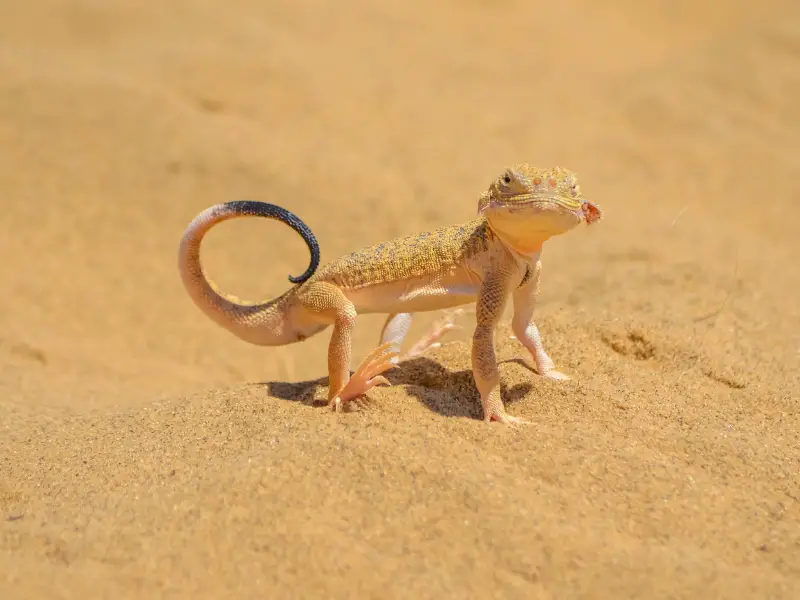
The toad-headed agama is a beginner-friendly lizard requiring minimal care and handling.
These docile animals are ever-curious and low-maintenance, making them perfect for young collectors and pet owners.
Food And Water
It’s essential that owners know what lizards eat and the toad-headed agama eats insects. However, you should vary the insects you feed to your lizard to ensure optimal health.
Only feed your agama(s) insects like cockroaches, worms, or crickets. All insects should be gut-loaded with suitable veggies before being fed to the agama.
If you have a young lizard that is under a year old, feed it daily. For older agamas, you can feed them every second day.
Once a week, you should dust the food with a calcium powder that contains vitamin D3. Twice a month, dust the feeder with a multivitamin powder. This will help your pet lizard stay healthy.
When it comes to water, add a small water dish to the enclosure, big enough for the agama to climb into should they want to soak.
However, they tend not to drink standing water so you should invest in an airstone or water pump that agitates their water source.
They can also consume water from misting a couple of times during the week. Should the agama want to drink, it’ll stick its tail in the air and lower its head.
This movement causes water to run down its body into its mouth.
Be careful not to soak your pet agama or the enclosure when misting though and do not over-mist the enclosure. As desert-dwelling lizards, they require a habitat with low humidity.
If you don’t want to do manual misting, consider an automatic reptile misting system.
Handling The Toad-Headed Agama
The toad-headed agama is a friendly, docile animal. It doesn’t require a lot of handling, but owners should interact with them regularly.
The regular interaction familiarizes the agama with its owner. This makes handling them or spot-cleaning the terrarium less stressful.
Be careful when handling your pet agama though as they’re sensitive, fragile animals.
Common Health Issues
Monitoring the lizard’s behavior, appetite, and energy is crucial. Consult a veterinarian for any signs of lethargy, lack of appetite, diarrhea, difficulty breathing, and stargazing.
Common ailments may include the following:
- Metabolic bone disease: This disease can cause deformities such as bowed legs and is caused by insufficient calcium intake and lack of vitamin D3. Lizards are more at risk of developing this disease if they only eat plants or insects. Provide essential lighting at proper levels for optimal vitamin D3 absorption.
- External parasites: Mites are the most common parasite to affect lizards. Look for red or black dots around the eyes, ears, and skin folds. Parasites cause the skin to become irritated and can be hard to get rid of.
- Reptile Respiratory Disease (RHD): Bacteria cause RHD. This disease makes breathing difficult and is often associated with eye and mouth discharge. Agamas with RHD may also become lethargic and lose their appetite.
Breeding
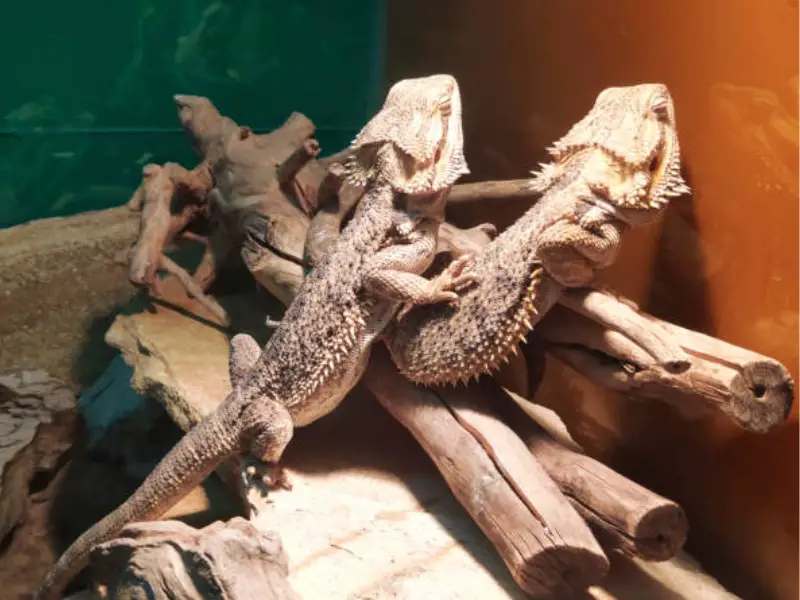
The toad-headed agama is an easy lizard to breed.
It typically takes 6 months for this lizard to mature and produce eggs. Females can have up to 5 clutches of eggs yearly. Each clutch, known as a grip, typically consists of 3 or 4 eggs.
The eggs hatch after 3 months, and the hatchlings will stay with their mothers to learn survival skills.
Choosing And Buying A Toad-Headed Agama
The toad-headed agama is a fantastic, easy animal to own. They love various environments, allowing pet owners to experiment and be more playful in their terrarium decorating.
It’s also pretty easy to find a young agama. They’re readily available from reputable pet shops, online stores, or reptile importers.
These lizards can cost between $50 and $220, depending on the seller.
Avoid buying older, lethargic agamas, and check the lizard for unusual spots or discharge before buying to avoid getting an unhealthy pet.
Always make sure you only buy from a reputable reptile store or breeder.
The toad-headed agama is perfect if you want an attractive, beginner-friendly lizard! This tiny lizard will provide you with years of pleasure and enjoyment.

